Archive for the ‘Wildlife A-Z’
-
Hum of the Ruby-throated Hummingbird
Posted in Wildlife A-Z | April 2, 2010 The striking red throat is characteristic of the male ruby-throated hummingbird. The female hummingbird lacks this coloration. The acrobatic style of flying has not been matched by other birds. They beat their wings nearly 53 times a second. If you wish to witness their ruby throats, you would need to exchange a quick glance. The ruby-throated hummingbird tends to hover frequently. They also fly upside down and backwards. Due to the presence of short legs, ruby-throated hummingbirds find it difficult to walk or hop. These hummingbirds primarily inhabit woodland regions. Gardens rich in flower density are also a famous zone for the ruby-throated hummingbird. They hover in the air to feed on flowers, nectar, and sap. In the process, they pollinate [...]
The striking red throat is characteristic of the male ruby-throated hummingbird. The female hummingbird lacks this coloration. The acrobatic style of flying has not been matched by other birds. They beat their wings nearly 53 times a second. If you wish to witness their ruby throats, you would need to exchange a quick glance. The ruby-throated hummingbird tends to hover frequently. They also fly upside down and backwards. Due to the presence of short legs, ruby-throated hummingbirds find it difficult to walk or hop. These hummingbirds primarily inhabit woodland regions. Gardens rich in flower density are also a famous zone for the ruby-throated hummingbird. They hover in the air to feed on flowers, nectar, and sap. In the process, they pollinate [...] -
Cute Chipmunks
Posted in Wildlife A-Z | April 1, 2010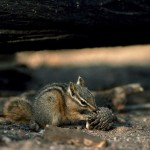 Chipmunks are members of the squirrel family. They are lively and speedy critters. They have pudgy cheeks and large, glossy eyes. In addition to this, they have wonderful stripes and bushy tails. These characteristics have attracted animators from Hollywood. Chipmunks have played quite a few substantial roles in Hollywood movies. There are nearly 25 species of chipmunks. Of these, all except one have been found in North America. Asia’s Tamias sibiricus is the only exception. Chipmunks have been found from Canada to Mexico. They generally scamper through the undergrowth of a number of environments from alpine forests to shrubby deserts. Many chipmunks dig burrows for their homes. Some of these burrows are complete with tunnels and chambers. [...]
Chipmunks are members of the squirrel family. They are lively and speedy critters. They have pudgy cheeks and large, glossy eyes. In addition to this, they have wonderful stripes and bushy tails. These characteristics have attracted animators from Hollywood. Chipmunks have played quite a few substantial roles in Hollywood movies. There are nearly 25 species of chipmunks. Of these, all except one have been found in North America. Asia’s Tamias sibiricus is the only exception. Chipmunks have been found from Canada to Mexico. They generally scamper through the undergrowth of a number of environments from alpine forests to shrubby deserts. Many chipmunks dig burrows for their homes. Some of these burrows are complete with tunnels and chambers. [...] -
Fabulous Flight of the Flying Snakes
Posted in Wildlife A-Z | April 1, 2010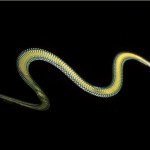 It may be frightening to picture a group of flying snakes. This could be the stuff that nightmares are made of. However, flying snakes are a reality in South and Southeast Asia. The term ‘flying snake’ may sound strange as these creatures do not reach high altitudes. They have strong updraft. They are generally gliders and use the speed of free falls with body contortions to remain in air and generate appropriate lift. The flying snake is thought to be more of a parachuter than a glider. Recent research has thrown up interesting facts on how these limbless creatures plummet in the air. By preparing for a take-off, a flying snake will move to the end of a branch and dangle in a ‘J’ shape. It then uses the lower half of the body to propel [...]
It may be frightening to picture a group of flying snakes. This could be the stuff that nightmares are made of. However, flying snakes are a reality in South and Southeast Asia. The term ‘flying snake’ may sound strange as these creatures do not reach high altitudes. They have strong updraft. They are generally gliders and use the speed of free falls with body contortions to remain in air and generate appropriate lift. The flying snake is thought to be more of a parachuter than a glider. Recent research has thrown up interesting facts on how these limbless creatures plummet in the air. By preparing for a take-off, a flying snake will move to the end of a branch and dangle in a ‘J’ shape. It then uses the lower half of the body to propel [...] -
Beauty of the Greater Flamingo
Posted in Wildlife A-Z | March 31, 2010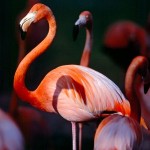 Greater flamingoes are pink beauties found in warm coastal regions of most continents. They prefer environments such as estuaries and alkaline or saline lakes. Greater flamingoes are surprisingly fluid swimmers when you take into account their appearance. They thrive in mud flats where they eat and breed. It is possible that the greater flamingo is the only tall, pink bird in a given location. Their necks are long and curved. Their bills have a characteristic black tip with a sharp bend. The shape of the bill helps them to feed on small organisms, including plankton, fish, and larvae of flies. Greater flamingoes utilize their long legs and webbed feet to move in the muddy flats and shallow water. Often, they bury their bills to take in mud and [...]
Greater flamingoes are pink beauties found in warm coastal regions of most continents. They prefer environments such as estuaries and alkaline or saline lakes. Greater flamingoes are surprisingly fluid swimmers when you take into account their appearance. They thrive in mud flats where they eat and breed. It is possible that the greater flamingo is the only tall, pink bird in a given location. Their necks are long and curved. Their bills have a characteristic black tip with a sharp bend. The shape of the bill helps them to feed on small organisms, including plankton, fish, and larvae of flies. Greater flamingoes utilize their long legs and webbed feet to move in the muddy flats and shallow water. Often, they bury their bills to take in mud and [...] -
Beautiful Bee-Eater – Part – II
Posted in Wildlife A-Z | March 23, 2010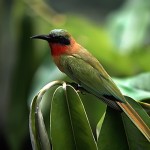 The birds have a wonderful time in Africa. Male bee-eaters have their own flocks. Grass fires attract bee-eaters in large numbers as there are plenty of insects. Spanish male birds mate with Italian female birds. It also common to see birds from Kazakhstan pair up with those from Hungary. It is back to Europe during springtime. Some of these pairs last for a lifetime. Their home usually comprises sandstone cliffs and sandy riverbanks. They hesitate to begin a family in a soiled nest. They excavate their own burrows. They have the ability to peck continuously for 20 days. At the end of the job, they have moved nearly 15 to 25 pounds of soil. This is more than 80 times their body weight. In the process, their beaks get chipped to one sixteenth [...]
The birds have a wonderful time in Africa. Male bee-eaters have their own flocks. Grass fires attract bee-eaters in large numbers as there are plenty of insects. Spanish male birds mate with Italian female birds. It also common to see birds from Kazakhstan pair up with those from Hungary. It is back to Europe during springtime. Some of these pairs last for a lifetime. Their home usually comprises sandstone cliffs and sandy riverbanks. They hesitate to begin a family in a soiled nest. They excavate their own burrows. They have the ability to peck continuously for 20 days. At the end of the job, they have moved nearly 15 to 25 pounds of soil. This is more than 80 times their body weight. In the process, their beaks get chipped to one sixteenth [...] -
Beautiful Bee-Eater – Part – I
Posted in Wildlife A-Z | March 22, 2010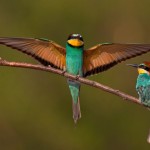 What is it with birds and poems? Keats had his nightingale, while Poe his raven. If I have to compare the life of the bee-eater with a literary work, it would be nothing short of an epic novel. The plot of the novel would be spread across several continents involving intrigue, theft, danger, chicanery, and gorgeous beauty. Can you guess how many colors are present on the body of the bee-eater? I, too, am at a loss for words. The chestnut crown blends beautifully with the black robber’s mask. The breast comprises of a turquoise blue, while the throat resembles the tinge of ripening wheat. I guess this is just what the doctor ordered for a bird that does not like to play it safe. The bee-eaters are true to their name: they eat bees. Besides [...]
What is it with birds and poems? Keats had his nightingale, while Poe his raven. If I have to compare the life of the bee-eater with a literary work, it would be nothing short of an epic novel. The plot of the novel would be spread across several continents involving intrigue, theft, danger, chicanery, and gorgeous beauty. Can you guess how many colors are present on the body of the bee-eater? I, too, am at a loss for words. The chestnut crown blends beautifully with the black robber’s mask. The breast comprises of a turquoise blue, while the throat resembles the tinge of ripening wheat. I guess this is just what the doctor ordered for a bird that does not like to play it safe. The bee-eaters are true to their name: they eat bees. Besides [...] -
Amazing Flight of the Albatross – Part – IV
Posted in Wildlife A-Z | March 22, 2010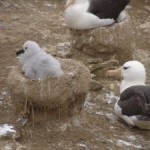 As I reached the north cliffs, the skies were covered with dense clouds. I was touched by the thousands of birds gliding through the shafts of the sun. They glided between the low heavens and pewter sea. Their braying and cooing lingers in the air. The scent of guano, too, is strong. The nests contain month-old chicks that sit like snowmen. As the adults arrive to feed them, I am spellbound. The adult albatross converts food into high-density oil that matches the calorific content of diesel. The parent and the chick greet each other with crossed bills. Following this, the adult squirts oil resembling the filling of a tank. Adults spend nearly 15 minutes feeding its chick. The chicks consume food three times its body weight. The adults then travel [...]
As I reached the north cliffs, the skies were covered with dense clouds. I was touched by the thousands of birds gliding through the shafts of the sun. They glided between the low heavens and pewter sea. Their braying and cooing lingers in the air. The scent of guano, too, is strong. The nests contain month-old chicks that sit like snowmen. As the adults arrive to feed them, I am spellbound. The adult albatross converts food into high-density oil that matches the calorific content of diesel. The parent and the chick greet each other with crossed bills. Following this, the adult squirts oil resembling the filling of a tank. Adults spend nearly 15 minutes feeding its chick. The chicks consume food three times its body weight. The adults then travel [...] -
Amazing Flight of the Albatross – Part – III
Posted in Wildlife A-Z | March 19, 2010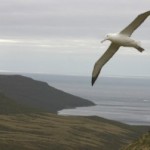 Campbell Island is the nesting place of the southern royal albatross. It lies 400 miles south of New Zealand. The island has fantastic waves and birds. The birds include giant petrels, shearwaters, and our very own albatross. The markings of the pintado petrels give them the appearance of flying dominoes. The tall cliffs obscure the island’s loneliness. There is a constant blowing of chilly winds. The Campbell albatross is unique to the island, with a grey head and light mantle. The brows are jet black in color. There are no vehicles on Campbell Island. The rhythm of the legs determines the time and distance covered. A 45-minute walk is the most direct route at leads to the birds. I have spotted many birds in the broad alley. I seem to misjudge [...]
Campbell Island is the nesting place of the southern royal albatross. It lies 400 miles south of New Zealand. The island has fantastic waves and birds. The birds include giant petrels, shearwaters, and our very own albatross. The markings of the pintado petrels give them the appearance of flying dominoes. The tall cliffs obscure the island’s loneliness. There is a constant blowing of chilly winds. The Campbell albatross is unique to the island, with a grey head and light mantle. The brows are jet black in color. There are no vehicles on Campbell Island. The rhythm of the legs determines the time and distance covered. A 45-minute walk is the most direct route at leads to the birds. I have spotted many birds in the broad alley. I seem to misjudge [...] -
Amazing Flight of the Albatross – Part – II
Posted in Wildlife A-Z | March 19, 2010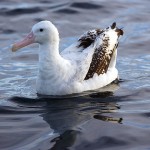 Albatrosses thrive in areas that cannot be imagined. Elemental islands are the primary areas. However, there exists no place untouched by humans. As a result, the population has been dwindling steadily. To make sure I got the best view, I chose the most populous albatross colony on the planet. The species are under threat of extinction. To increase their numbers, we need to sign a deal with them. Failing which, we may never again lay sight on so beautiful a species. Falklands’ Steeple Jason Island is graceful with tussock grass growing to head height. As I walked around the island, I witnessed a living miracle: a group of black-browed albatrosses crowding the ledges and shoreline. The heads of the birds are decorated with black stripes, just [...]
Albatrosses thrive in areas that cannot be imagined. Elemental islands are the primary areas. However, there exists no place untouched by humans. As a result, the population has been dwindling steadily. To make sure I got the best view, I chose the most populous albatross colony on the planet. The species are under threat of extinction. To increase their numbers, we need to sign a deal with them. Failing which, we may never again lay sight on so beautiful a species. Falklands’ Steeple Jason Island is graceful with tussock grass growing to head height. As I walked around the island, I witnessed a living miracle: a group of black-browed albatrosses crowding the ledges and shoreline. The heads of the birds are decorated with black stripes, just [...] -
Amazing Flight of the Albatross – Part – I
Posted in Wildlife A-Z | March 18, 2010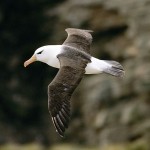 What comes to your mind when you think of a flying machine? Can it be the albatross which is designed to be one of the best flying species on the planet? The albatross is made up bone, feathers, muscle and wind, which give the bird its flying prowess. Watching the bird in full flight gives the impression as if it were propelled into the sky. The albatross is more of an art deco bird, which has striking patterns. It is known for its faithfulness and epic travels. Parent albatrosses are known to fly for more than 10,000 miles to feed their chicks. They have the longest wings in the world, stretching up to 3.5 meters. These beauties can glide for hundreds of miles without flapping their wings. Besides crossing ocean basins, they have circumnavigated [...]
What comes to your mind when you think of a flying machine? Can it be the albatross which is designed to be one of the best flying species on the planet? The albatross is made up bone, feathers, muscle and wind, which give the bird its flying prowess. Watching the bird in full flight gives the impression as if it were propelled into the sky. The albatross is more of an art deco bird, which has striking patterns. It is known for its faithfulness and epic travels. Parent albatrosses are known to fly for more than 10,000 miles to feed their chicks. They have the longest wings in the world, stretching up to 3.5 meters. These beauties can glide for hundreds of miles without flapping their wings. Besides crossing ocean basins, they have circumnavigated [...]


